Tiger Air Opportunity Analysis: Market Position and Strategy
VerifiedAdded on 2023/06/11
|6
|1969
|393
Case Study
AI Summary
This case study provides an in-depth opportunity analysis of Tiger Air, a Singapore-based airline, examining its market position and strategic options. The analysis includes a PESTLE framework, evaluating the political, social, economic, legal, environmental, and technological factors influencing Tiger Air's operations. Porter's Five Forces model is applied to assess the bargaining power of suppliers and customers, the threat of new entrants and substitute goods, and the intensity of competitive rivalry within the airline industry. A SWOT analysis identifies Tiger Air's strengths, weaknesses, opportunities, and threats, highlighting its dominant position in the regional low-cost airline sector, potential vulnerabilities to economic crises, and opportunities for expansion within Asia. The study concludes with recommendations for leveraging marketing and operational strategies to enhance Tiger Air's market share and brand recognition. Desklib provides this assignment solution and a wealth of study resources for students.
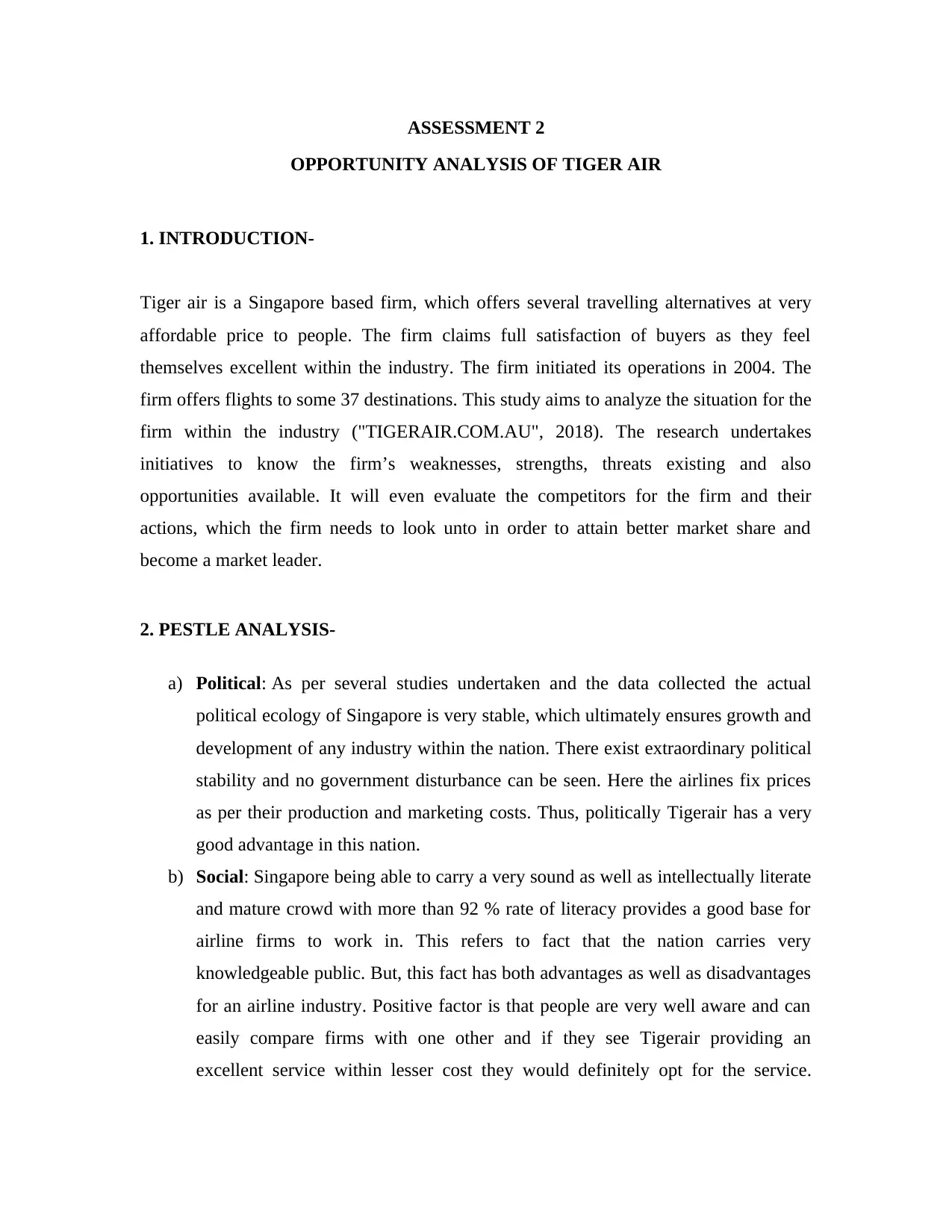
ASSESSMENT 2
OPPORTUNITY ANALYSIS OF TIGER AIR
1. INTRODUCTION-
Tiger air is a Singapore based firm, which offers several travelling alternatives at very
affordable price to people. The firm claims full satisfaction of buyers as they feel
themselves excellent within the industry. The firm initiated its operations in 2004. The
firm offers flights to some 37 destinations. This study aims to analyze the situation for the
firm within the industry ("TIGERAIR.COM.AU", 2018). The research undertakes
initiatives to know the firm’s weaknesses, strengths, threats existing and also
opportunities available. It will even evaluate the competitors for the firm and their
actions, which the firm needs to look unto in order to attain better market share and
become a market leader.
2. PESTLE ANALYSIS-
a) Political: As per several studies undertaken and the data collected the actual
political ecology of Singapore is very stable, which ultimately ensures growth and
development of any industry within the nation. There exist extraordinary political
stability and no government disturbance can be seen. Here the airlines fix prices
as per their production and marketing costs. Thus, politically Tigerair has a very
good advantage in this nation.
b) Social: Singapore being able to carry a very sound as well as intellectually literate
and mature crowd with more than 92 % rate of literacy provides a good base for
airline firms to work in. This refers to fact that the nation carries very
knowledgeable public. But, this fact has both advantages as well as disadvantages
for an airline industry. Positive factor is that people are very well aware and can
easily compare firms with one other and if they see Tigerair providing an
excellent service within lesser cost they would definitely opt for the service.
OPPORTUNITY ANALYSIS OF TIGER AIR
1. INTRODUCTION-
Tiger air is a Singapore based firm, which offers several travelling alternatives at very
affordable price to people. The firm claims full satisfaction of buyers as they feel
themselves excellent within the industry. The firm initiated its operations in 2004. The
firm offers flights to some 37 destinations. This study aims to analyze the situation for the
firm within the industry ("TIGERAIR.COM.AU", 2018). The research undertakes
initiatives to know the firm’s weaknesses, strengths, threats existing and also
opportunities available. It will even evaluate the competitors for the firm and their
actions, which the firm needs to look unto in order to attain better market share and
become a market leader.
2. PESTLE ANALYSIS-
a) Political: As per several studies undertaken and the data collected the actual
political ecology of Singapore is very stable, which ultimately ensures growth and
development of any industry within the nation. There exist extraordinary political
stability and no government disturbance can be seen. Here the airlines fix prices
as per their production and marketing costs. Thus, politically Tigerair has a very
good advantage in this nation.
b) Social: Singapore being able to carry a very sound as well as intellectually literate
and mature crowd with more than 92 % rate of literacy provides a good base for
airline firms to work in. This refers to fact that the nation carries very
knowledgeable public. But, this fact has both advantages as well as disadvantages
for an airline industry. Positive factor is that people are very well aware and can
easily compare firms with one other and if they see Tigerair providing an
excellent service within lesser cost they would definitely opt for the service.
Paraphrase This Document
Need a fresh take? Get an instant paraphrase of this document with our AI Paraphraser
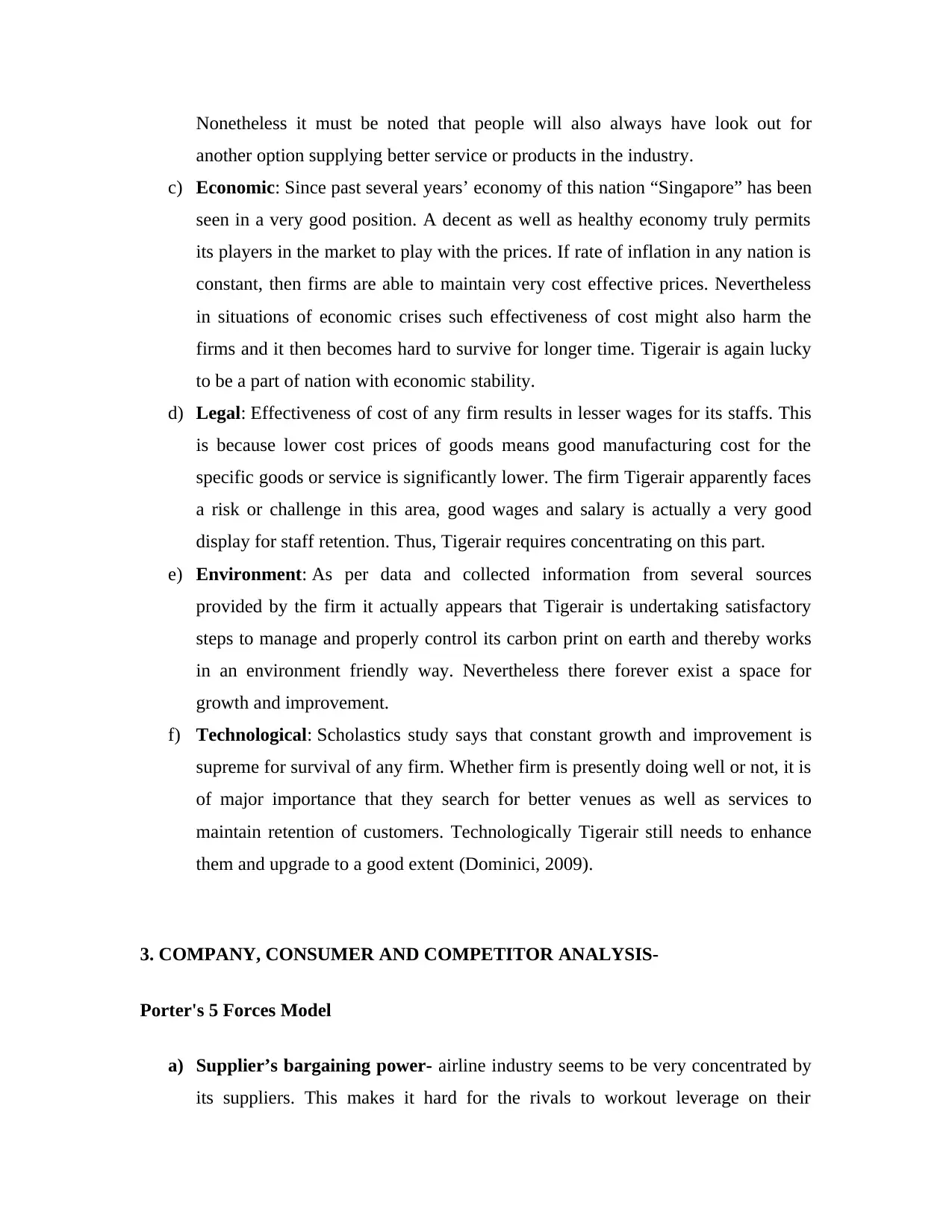
Nonetheless it must be noted that people will also always have look out for
another option supplying better service or products in the industry.
c) Economic: Since past several years’ economy of this nation “Singapore” has been
seen in a very good position. A decent as well as healthy economy truly permits
its players in the market to play with the prices. If rate of inflation in any nation is
constant, then firms are able to maintain very cost effective prices. Nevertheless
in situations of economic crises such effectiveness of cost might also harm the
firms and it then becomes hard to survive for longer time. Tigerair is again lucky
to be a part of nation with economic stability.
d) Legal: Effectiveness of cost of any firm results in lesser wages for its staffs. This
is because lower cost prices of goods means good manufacturing cost for the
specific goods or service is significantly lower. The firm Tigerair apparently faces
a risk or challenge in this area, good wages and salary is actually a very good
display for staff retention. Thus, Tigerair requires concentrating on this part.
e) Environment: As per data and collected information from several sources
provided by the firm it actually appears that Tigerair is undertaking satisfactory
steps to manage and properly control its carbon print on earth and thereby works
in an environment friendly way. Nevertheless there forever exist a space for
growth and improvement.
f) Technological: Scholastics study says that constant growth and improvement is
supreme for survival of any firm. Whether firm is presently doing well or not, it is
of major importance that they search for better venues as well as services to
maintain retention of customers. Technologically Tigerair still needs to enhance
them and upgrade to a good extent (Dominici, 2009).
3. COMPANY, CONSUMER AND COMPETITOR ANALYSIS-
Porter's 5 Forces Model
a) Supplier’s bargaining power- airline industry seems to be very concentrated by
its suppliers. This makes it hard for the rivals to workout leverage on their
another option supplying better service or products in the industry.
c) Economic: Since past several years’ economy of this nation “Singapore” has been
seen in a very good position. A decent as well as healthy economy truly permits
its players in the market to play with the prices. If rate of inflation in any nation is
constant, then firms are able to maintain very cost effective prices. Nevertheless
in situations of economic crises such effectiveness of cost might also harm the
firms and it then becomes hard to survive for longer time. Tigerair is again lucky
to be a part of nation with economic stability.
d) Legal: Effectiveness of cost of any firm results in lesser wages for its staffs. This
is because lower cost prices of goods means good manufacturing cost for the
specific goods or service is significantly lower. The firm Tigerair apparently faces
a risk or challenge in this area, good wages and salary is actually a very good
display for staff retention. Thus, Tigerair requires concentrating on this part.
e) Environment: As per data and collected information from several sources
provided by the firm it actually appears that Tigerair is undertaking satisfactory
steps to manage and properly control its carbon print on earth and thereby works
in an environment friendly way. Nevertheless there forever exist a space for
growth and improvement.
f) Technological: Scholastics study says that constant growth and improvement is
supreme for survival of any firm. Whether firm is presently doing well or not, it is
of major importance that they search for better venues as well as services to
maintain retention of customers. Technologically Tigerair still needs to enhance
them and upgrade to a good extent (Dominici, 2009).
3. COMPANY, CONSUMER AND COMPETITOR ANALYSIS-
Porter's 5 Forces Model
a) Supplier’s bargaining power- airline industry seems to be very concentrated by
its suppliers. This makes it hard for the rivals to workout leverage on their
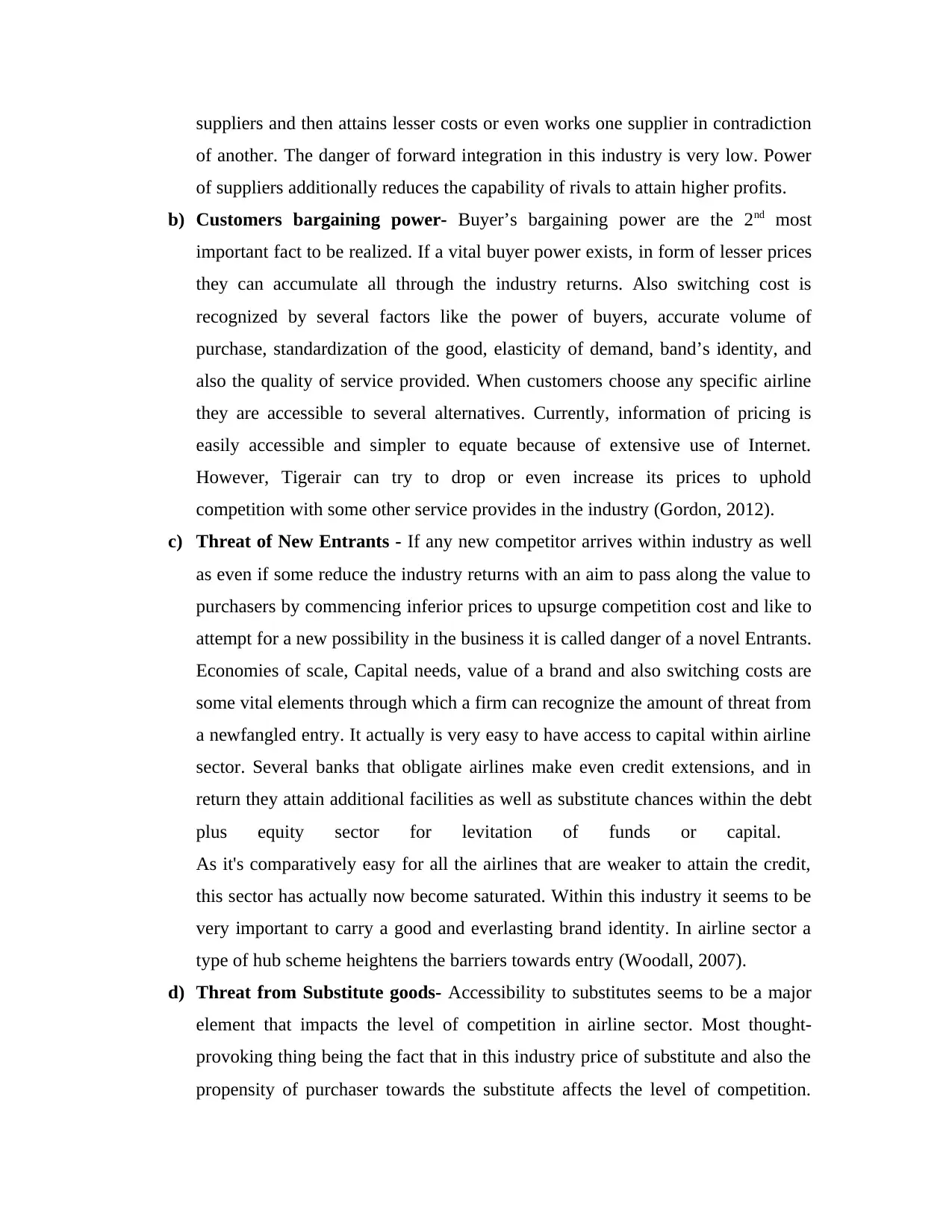
suppliers and then attains lesser costs or even works one supplier in contradiction
of another. The danger of forward integration in this industry is very low. Power
of suppliers additionally reduces the capability of rivals to attain higher profits.
b) Customers bargaining power- Buyer’s bargaining power are the 2nd most
important fact to be realized. If a vital buyer power exists, in form of lesser prices
they can accumulate all through the industry returns. Also switching cost is
recognized by several factors like the power of buyers, accurate volume of
purchase, standardization of the good, elasticity of demand, band’s identity, and
also the quality of service provided. When customers choose any specific airline
they are accessible to several alternatives. Currently, information of pricing is
easily accessible and simpler to equate because of extensive use of Internet.
However, Tigerair can try to drop or even increase its prices to uphold
competition with some other service provides in the industry (Gordon, 2012).
c) Threat of New Entrants - If any new competitor arrives within industry as well
as even if some reduce the industry returns with an aim to pass along the value to
purchasers by commencing inferior prices to upsurge competition cost and like to
attempt for a new possibility in the business it is called danger of a novel Entrants.
Economies of scale, Capital needs, value of a brand and also switching costs are
some vital elements through which a firm can recognize the amount of threat from
a newfangled entry. It actually is very easy to have access to capital within airline
sector. Several banks that obligate airlines make even credit extensions, and in
return they attain additional facilities as well as substitute chances within the debt
plus equity sector for levitation of funds or capital.
As it's comparatively easy for all the airlines that are weaker to attain the credit,
this sector has actually now become saturated. Within this industry it seems to be
very important to carry a good and everlasting brand identity. In airline sector a
type of hub scheme heightens the barriers towards entry (Woodall, 2007).
d) Threat from Substitute goods- Accessibility to substitutes seems to be a major
element that impacts the level of competition in airline sector. Most thought-
provoking thing being the fact that in this industry price of substitute and also the
propensity of purchaser towards the substitute affects the level of competition.
of another. The danger of forward integration in this industry is very low. Power
of suppliers additionally reduces the capability of rivals to attain higher profits.
b) Customers bargaining power- Buyer’s bargaining power are the 2nd most
important fact to be realized. If a vital buyer power exists, in form of lesser prices
they can accumulate all through the industry returns. Also switching cost is
recognized by several factors like the power of buyers, accurate volume of
purchase, standardization of the good, elasticity of demand, band’s identity, and
also the quality of service provided. When customers choose any specific airline
they are accessible to several alternatives. Currently, information of pricing is
easily accessible and simpler to equate because of extensive use of Internet.
However, Tigerair can try to drop or even increase its prices to uphold
competition with some other service provides in the industry (Gordon, 2012).
c) Threat of New Entrants - If any new competitor arrives within industry as well
as even if some reduce the industry returns with an aim to pass along the value to
purchasers by commencing inferior prices to upsurge competition cost and like to
attempt for a new possibility in the business it is called danger of a novel Entrants.
Economies of scale, Capital needs, value of a brand and also switching costs are
some vital elements through which a firm can recognize the amount of threat from
a newfangled entry. It actually is very easy to have access to capital within airline
sector. Several banks that obligate airlines make even credit extensions, and in
return they attain additional facilities as well as substitute chances within the debt
plus equity sector for levitation of funds or capital.
As it's comparatively easy for all the airlines that are weaker to attain the credit,
this sector has actually now become saturated. Within this industry it seems to be
very important to carry a good and everlasting brand identity. In airline sector a
type of hub scheme heightens the barriers towards entry (Woodall, 2007).
d) Threat from Substitute goods- Accessibility to substitutes seems to be a major
element that impacts the level of competition in airline sector. Most thought-
provoking thing being the fact that in this industry price of substitute and also the
propensity of purchaser towards the substitute affects the level of competition.
⊘ This is a preview!⊘
Do you want full access?
Subscribe today to unlock all pages.

Trusted by 1+ million students worldwide
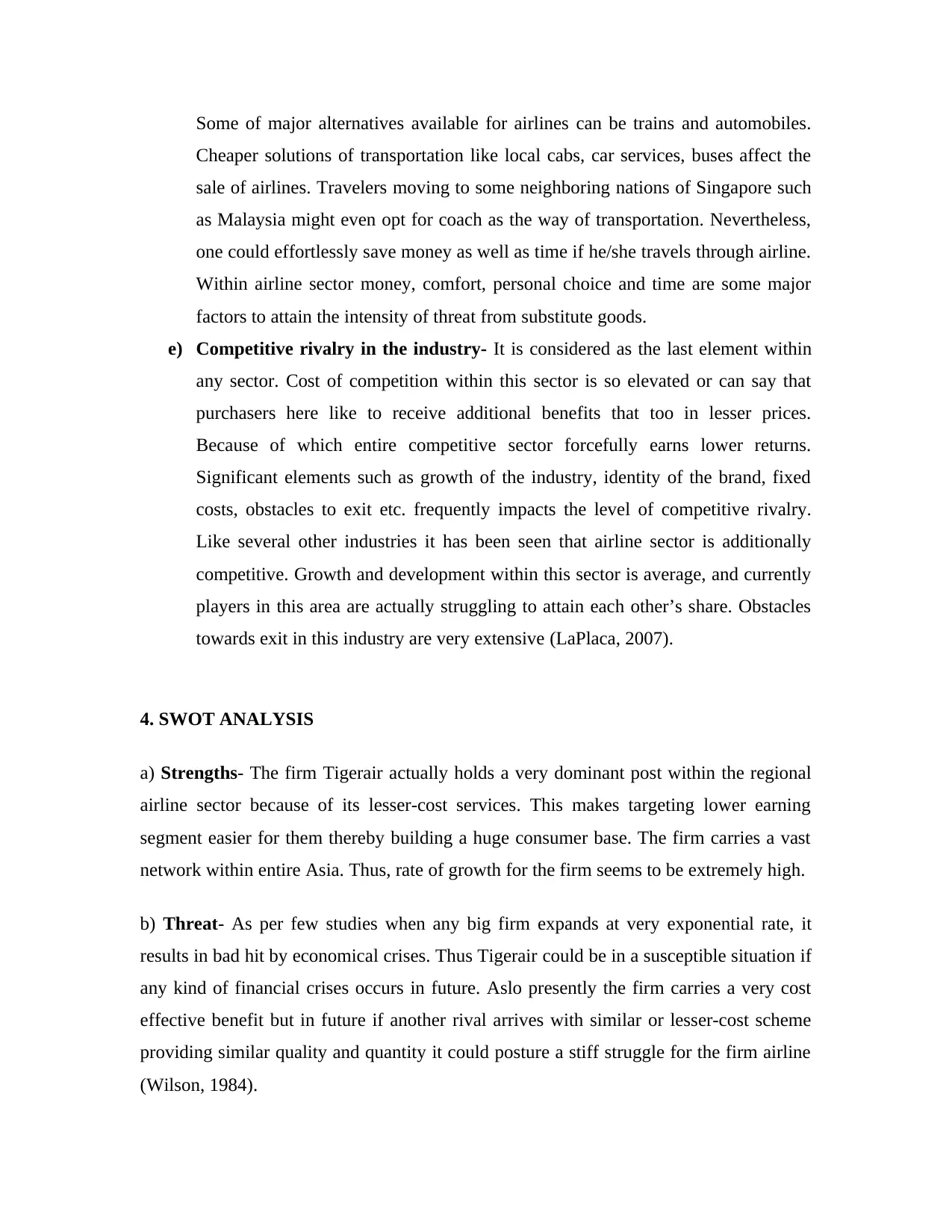
Some of major alternatives available for airlines can be trains and automobiles.
Cheaper solutions of transportation like local cabs, car services, buses affect the
sale of airlines. Travelers moving to some neighboring nations of Singapore such
as Malaysia might even opt for coach as the way of transportation. Nevertheless,
one could effortlessly save money as well as time if he/she travels through airline.
Within airline sector money, comfort, personal choice and time are some major
factors to attain the intensity of threat from substitute goods.
e) Competitive rivalry in the industry- It is considered as the last element within
any sector. Cost of competition within this sector is so elevated or can say that
purchasers here like to receive additional benefits that too in lesser prices.
Because of which entire competitive sector forcefully earns lower returns.
Significant elements such as growth of the industry, identity of the brand, fixed
costs, obstacles to exit etc. frequently impacts the level of competitive rivalry.
Like several other industries it has been seen that airline sector is additionally
competitive. Growth and development within this sector is average, and currently
players in this area are actually struggling to attain each other’s share. Obstacles
towards exit in this industry are very extensive (LaPlaca, 2007).
4. SWOT ANALYSIS
a) Strengths- The firm Tigerair actually holds a very dominant post within the regional
airline sector because of its lesser-cost services. This makes targeting lower earning
segment easier for them thereby building a huge consumer base. The firm carries a vast
network within entire Asia. Thus, rate of growth for the firm seems to be extremely high.
b) Threat- As per few studies when any big firm expands at very exponential rate, it
results in bad hit by economical crises. Thus Tigerair could be in a susceptible situation if
any kind of financial crises occurs in future. Aslo presently the firm carries a very cost
effective benefit but in future if another rival arrives with similar or lesser-cost scheme
providing similar quality and quantity it could posture a stiff struggle for the firm airline
(Wilson, 1984).
Cheaper solutions of transportation like local cabs, car services, buses affect the
sale of airlines. Travelers moving to some neighboring nations of Singapore such
as Malaysia might even opt for coach as the way of transportation. Nevertheless,
one could effortlessly save money as well as time if he/she travels through airline.
Within airline sector money, comfort, personal choice and time are some major
factors to attain the intensity of threat from substitute goods.
e) Competitive rivalry in the industry- It is considered as the last element within
any sector. Cost of competition within this sector is so elevated or can say that
purchasers here like to receive additional benefits that too in lesser prices.
Because of which entire competitive sector forcefully earns lower returns.
Significant elements such as growth of the industry, identity of the brand, fixed
costs, obstacles to exit etc. frequently impacts the level of competitive rivalry.
Like several other industries it has been seen that airline sector is additionally
competitive. Growth and development within this sector is average, and currently
players in this area are actually struggling to attain each other’s share. Obstacles
towards exit in this industry are very extensive (LaPlaca, 2007).
4. SWOT ANALYSIS
a) Strengths- The firm Tigerair actually holds a very dominant post within the regional
airline sector because of its lesser-cost services. This makes targeting lower earning
segment easier for them thereby building a huge consumer base. The firm carries a vast
network within entire Asia. Thus, rate of growth for the firm seems to be extremely high.
b) Threat- As per few studies when any big firm expands at very exponential rate, it
results in bad hit by economical crises. Thus Tigerair could be in a susceptible situation if
any kind of financial crises occurs in future. Aslo presently the firm carries a very cost
effective benefit but in future if another rival arrives with similar or lesser-cost scheme
providing similar quality and quantity it could posture a stiff struggle for the firm airline
(Wilson, 1984).
Paraphrase This Document
Need a fresh take? Get an instant paraphrase of this document with our AI Paraphraser
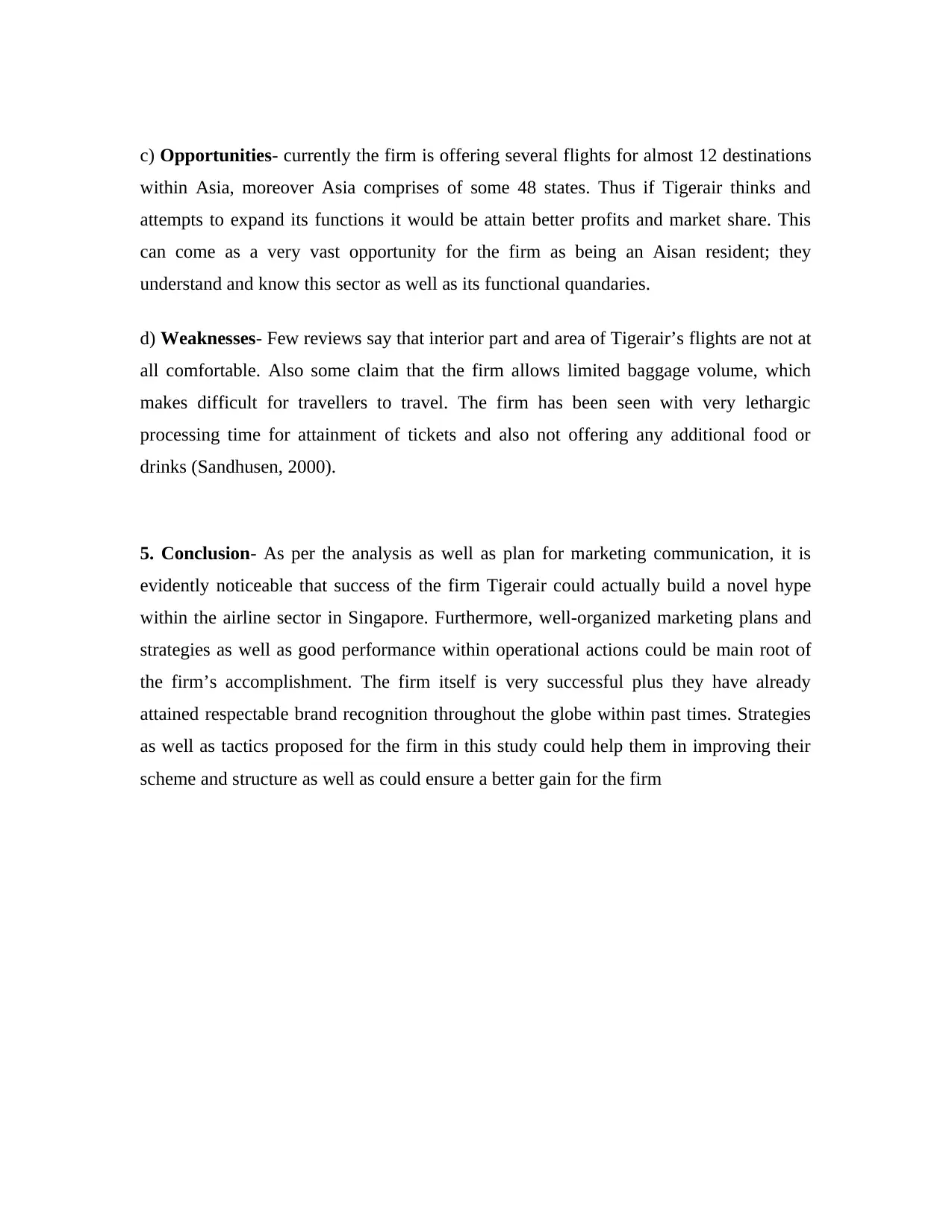
c) Opportunities- currently the firm is offering several flights for almost 12 destinations
within Asia, moreover Asia comprises of some 48 states. Thus if Tigerair thinks and
attempts to expand its functions it would be attain better profits and market share. This
can come as a very vast opportunity for the firm as being an Aisan resident; they
understand and know this sector as well as its functional quandaries.
d) Weaknesses- Few reviews say that interior part and area of Tigerair’s flights are not at
all comfortable. Also some claim that the firm allows limited baggage volume, which
makes difficult for travellers to travel. The firm has been seen with very lethargic
processing time for attainment of tickets and also not offering any additional food or
drinks (Sandhusen, 2000).
5. Conclusion- As per the analysis as well as plan for marketing communication, it is
evidently noticeable that success of the firm Tigerair could actually build a novel hype
within the airline sector in Singapore. Furthermore, well-organized marketing plans and
strategies as well as good performance within operational actions could be main root of
the firm’s accomplishment. The firm itself is very successful plus they have already
attained respectable brand recognition throughout the globe within past times. Strategies
as well as tactics proposed for the firm in this study could help them in improving their
scheme and structure as well as could ensure a better gain for the firm
within Asia, moreover Asia comprises of some 48 states. Thus if Tigerair thinks and
attempts to expand its functions it would be attain better profits and market share. This
can come as a very vast opportunity for the firm as being an Aisan resident; they
understand and know this sector as well as its functional quandaries.
d) Weaknesses- Few reviews say that interior part and area of Tigerair’s flights are not at
all comfortable. Also some claim that the firm allows limited baggage volume, which
makes difficult for travellers to travel. The firm has been seen with very lethargic
processing time for attainment of tickets and also not offering any additional food or
drinks (Sandhusen, 2000).
5. Conclusion- As per the analysis as well as plan for marketing communication, it is
evidently noticeable that success of the firm Tigerair could actually build a novel hype
within the airline sector in Singapore. Furthermore, well-organized marketing plans and
strategies as well as good performance within operational actions could be main root of
the firm’s accomplishment. The firm itself is very successful plus they have already
attained respectable brand recognition throughout the globe within past times. Strategies
as well as tactics proposed for the firm in this study could help them in improving their
scheme and structure as well as could ensure a better gain for the firm
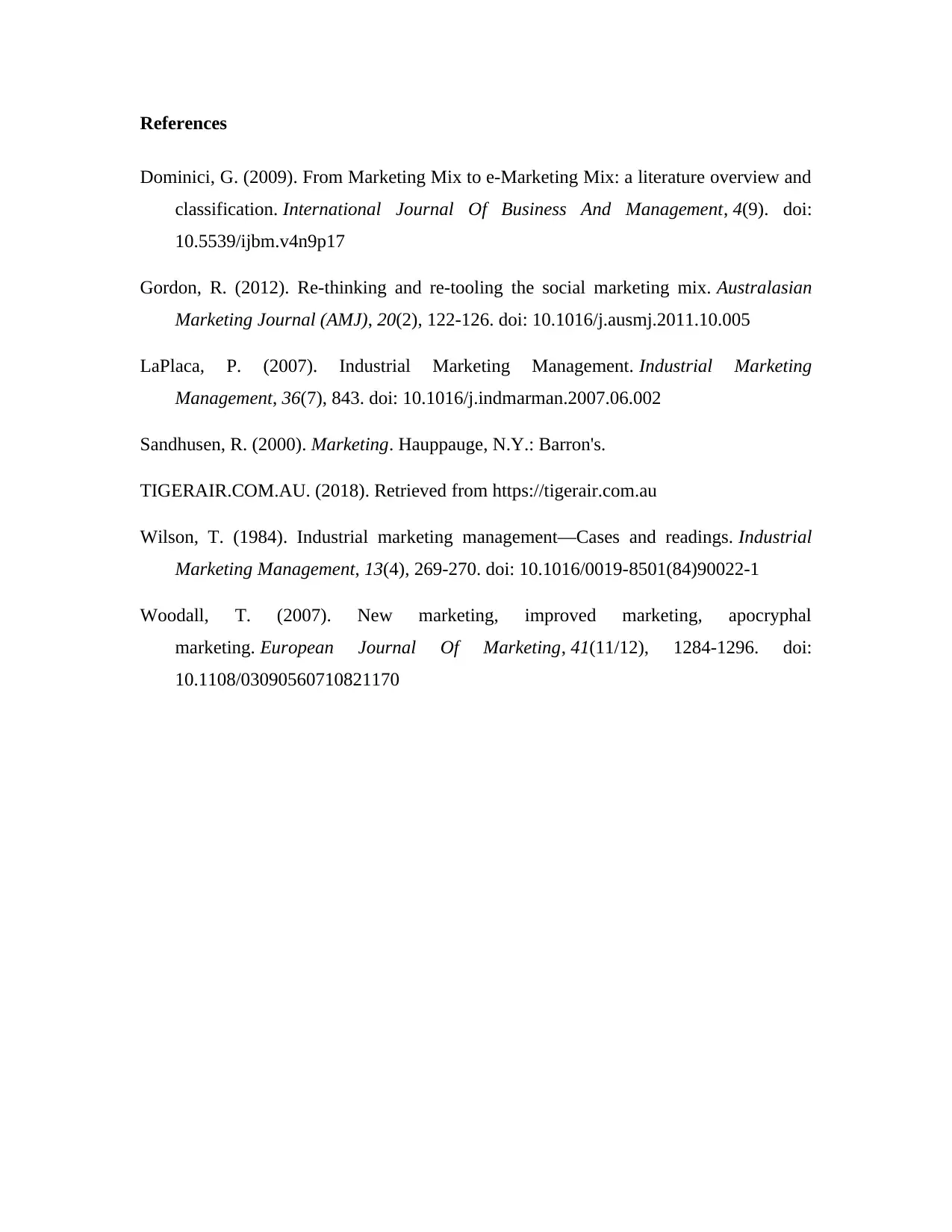
References
Dominici, G. (2009). From Marketing Mix to e-Marketing Mix: a literature overview and
classification. International Journal Of Business And Management, 4(9). doi:
10.5539/ijbm.v4n9p17
Gordon, R. (2012). Re-thinking and re-tooling the social marketing mix. Australasian
Marketing Journal (AMJ), 20(2), 122-126. doi: 10.1016/j.ausmj.2011.10.005
LaPlaca, P. (2007). Industrial Marketing Management. Industrial Marketing
Management, 36(7), 843. doi: 10.1016/j.indmarman.2007.06.002
Sandhusen, R. (2000). Marketing. Hauppauge, N.Y.: Barron's.
TIGERAIR.COM.AU. (2018). Retrieved from https://tigerair.com.au
Wilson, T. (1984). Industrial marketing management—Cases and readings. Industrial
Marketing Management, 13(4), 269-270. doi: 10.1016/0019-8501(84)90022-1
Woodall, T. (2007). New marketing, improved marketing, apocryphal
marketing. European Journal Of Marketing, 41(11/12), 1284-1296. doi:
10.1108/03090560710821170
Dominici, G. (2009). From Marketing Mix to e-Marketing Mix: a literature overview and
classification. International Journal Of Business And Management, 4(9). doi:
10.5539/ijbm.v4n9p17
Gordon, R. (2012). Re-thinking and re-tooling the social marketing mix. Australasian
Marketing Journal (AMJ), 20(2), 122-126. doi: 10.1016/j.ausmj.2011.10.005
LaPlaca, P. (2007). Industrial Marketing Management. Industrial Marketing
Management, 36(7), 843. doi: 10.1016/j.indmarman.2007.06.002
Sandhusen, R. (2000). Marketing. Hauppauge, N.Y.: Barron's.
TIGERAIR.COM.AU. (2018). Retrieved from https://tigerair.com.au
Wilson, T. (1984). Industrial marketing management—Cases and readings. Industrial
Marketing Management, 13(4), 269-270. doi: 10.1016/0019-8501(84)90022-1
Woodall, T. (2007). New marketing, improved marketing, apocryphal
marketing. European Journal Of Marketing, 41(11/12), 1284-1296. doi:
10.1108/03090560710821170
⊘ This is a preview!⊘
Do you want full access?
Subscribe today to unlock all pages.

Trusted by 1+ million students worldwide
1 out of 6
Related Documents
Your All-in-One AI-Powered Toolkit for Academic Success.
+13062052269
info@desklib.com
Available 24*7 on WhatsApp / Email
![[object Object]](/_next/static/media/star-bottom.7253800d.svg)
Unlock your academic potential
Copyright © 2020–2025 A2Z Services. All Rights Reserved. Developed and managed by ZUCOL.





